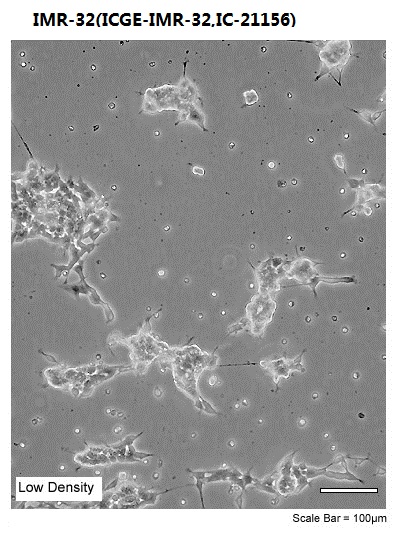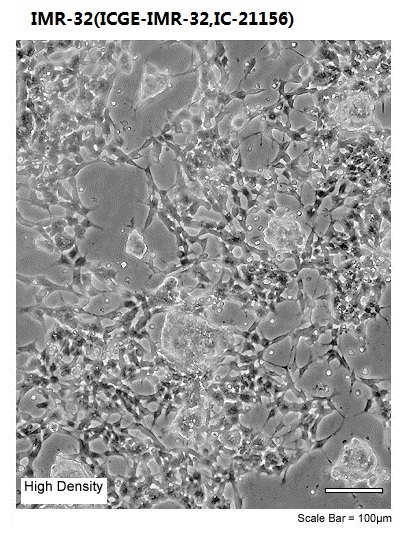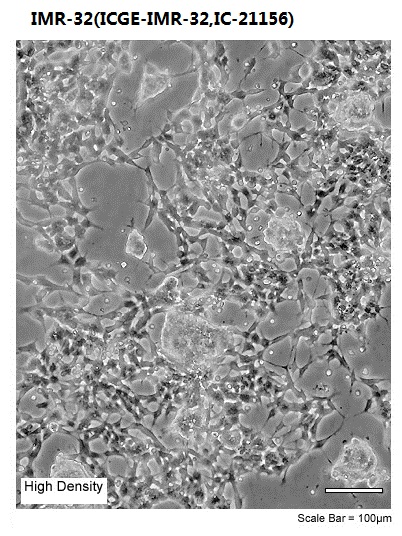


Overview
| Organism | Homo sapiens, human |
|---|---|
| Tissue | brain; derived from metastatic site: abdominal mass |
| Cell Type | neuroblast |
| Product Format | frozen |
| Morphology | fibroblast; neuroblast |
| Culture Properties | adherent |
| Biosafety Level |
1
Biosafety classification is based on U.S. Public Health Service Guidelines, it is the responsibility of the customer to ensure that their facilities comply with biosafety regulations for their own country. |
| Disease | neuroblastoma |
| Age | 13 months |
| Gender | male |
| Ethnicity | Caucasian |
| Applications |
This cell line is a suitable transfection host.
|
| Storage Conditions | liquid nitrogen vapor phase |
Properties
| Karyotype | Stable male karyotype with stemline number of 49. Two large marker chromosomes with submedian centromeres. A deletion in one number 1 chromosome: One number 16 chromosome missing; two extra chromosomes in C group. Sublines with 50 and 48 chromosomes differ from those with 49 chromosomes by having an extra or missing C group chromosome respectively. Note: Cytogenetic information is based on initial seed stock at ATCC. Cytogenetic instability has been reported in the literature for some cell lines. |
|---|---|
|
|
|
| Derivation |
The IMR-32 cell line was established by W.W. Nichols, J. Lee and S. Dwight in April, 1967 from an abdominal mass occurring in a 13-month-old Caucasian male. The tumor was diagnosed as a neuroblastoma with rare areas of organoid differentiation.
|
| Clinical Data |
13 months
Caucasian
male
|
| Virus Susceptibility |
Vesicular stomatitis, Orsay (Indiana) Vesicular stomatitis, Glasgow (Indiana) Herpes simplex virus Vaccinia virus Human Coxsackievirus B3 Human poliovirus 3 |
| Virus Resistance | {8B5AD8F2-1676-4399-B5A1-85F54726A74D} |
| Comments |
Two cell types are present. Predominant is a small neuroblast-like cell.The other is a large hyaline fibroblast.
IMR-32 cells may pile up and grow in patches. IMR-32 cells may not become 100% confluent. |
Background
| Complete Growth Medium |
The base medium for this cell line is ATCC-formulated Eagle''''''''s Minimum Essential Medium, Catalog No. 30-2003. To make the complete growth medium, add the following components to the base medium: fetal bovine serum to a final concentration of 10%. |
|---|---|
| Subculturing |
Volumes used in this protocol are for 75 cm2 flasks; proportionally reduce or increase amount of dissociation medium for culture vessels of other sizes.
Subcultivation Ratio: A subcultivation ratio of 1:3 to 1:6 is recommended
Medium Renewal: Every 2 to 3 days
|
| Cryopreservation |
Freeze medium: Complete growth medium 95%; DMSO, 5%
Storage temperature: liquid nitrogen vapor temperature
|
| Culture Conditions |
Temperature: 37��C
|


